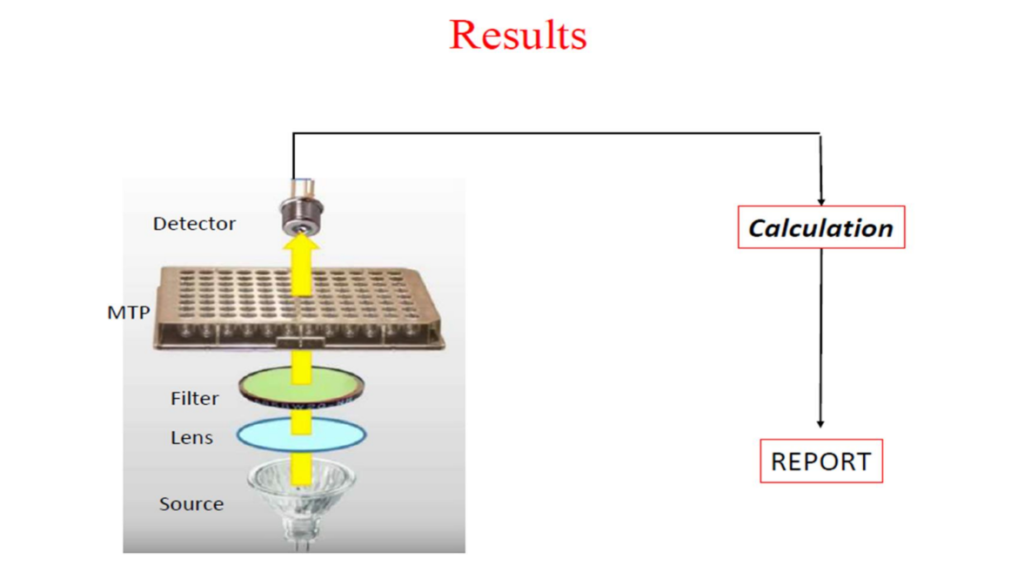Enzyme Linked Immunosorbent Assay (ELISA)
Enzyme-linked immunosorbent assay or ELISA test procedure is a common laboratory test procedure used to detect the presence of an antigen or antibody in a sample. The test is based on the principle of antibody-antigen binding.
- ELISA is an antigen antibody reaction.
- In 1971, ELISA was introduced by Peter Perlmann and Eva Engvall at
Stockholm University in Sweden. - It is a common laboratory technique which is usually used to measure
the concentration of antibodies or antigens in blood. - ELISA is a plate-based assay technique which is used for detecting and
quantifying substances such as peptides, proteins, antibodies and
hormones.


Principle of ELISA Test Procedure :
- ELISAs are typically performed in 96-well polystyrene plates. The serum is
incubated in a well, and each well contains a different serum. A positive
control serum and a negative control serum would be included among the
96 samples being tested. - Antibodies or antigens present in serum are captured by corresponding
antigen or antibody coated on to the solid surface. After some time, the
plate is washed to remove serum and unbound antibodies or antigens - To detect the bound antibodies or antigens, a secondary antibody that is
attached to an enzyme such as peroxidase or alkaline phosphatase are
added to each well. After an incubation period, the unbound secondary
antibodies are washed off. - When a suitable substrate is added, the enzyme reacts with it to produce a
color. This color produced is measurable as a function or quantity of antigens
or antibodies present in the given sample. The intensity of color/ optical
density is measured at 450nm. The intensity of the color gives an indication of
the amount of antigen or antibody.

Most commonly used Enzyme/Substrate
Substrates:
- Orthophenylene diamine (OPD)
- Para-nitrophenyl phosphate
(PNP) - Tetra Methylene Benzidine
Hydrochloride (TMBH) - 5-amino salicyclic acid
Enzymes:
- Alkaline Phosphatase
- Horse Reddish Peroxide
Blocking Protein:
- Bovine Serum Albumin (BSA)
Types of ELISA Test Procedure :
- Direct ELISA
- Indirect ELISA
- Sandwich ELISA
- Competitive ELISA

1. Direct ELISA



2. Indirect ELISA


3. Sandwich ELISA


4. Competitive ELISA
- This test is used to measure the concentration of an antigen in a sample.
In this test, antibody is first incubated in solution with a sample containing
antigen. - The antigen-antibody mixture is then added to the microtiter well which is
coated with antigen. - The more the antigen present in the sample, the less free antibody will be
available to bind to the antigen-coated well. After the well is washed,
enzyme conjugated secondary antibody specific for isotype of the primary
antibody is added to determine the amount of primary antibody bound to
the well. - The higher the concentration of antigen in the sample, the lower the
absorbance.
Procedure of Competitive ELISA :
- Antibody is incubated with sample containing antigen.
- Antigen-antibody complex are added to the microtiter well which are
pre-coated with the antigen. - Wash the plate to remove unbound antibody.
- Enzyme linked secondary antibody which is specific to the primary
antibody is added. - Wash the plate, so that unbound enzyme-linked antibodies are removed.
- Add substrate which is converted by the enzyme into a fluorescent signal.

Comparison among ELISA Test Procedure Methods



Application of ELISA:
❑ Presence of antigen or the presence of antibody in a
sample can be evaluated.
❑ Determination of serum antibody concentrations in a
virus test.
❑ Used in food industry when detecting potential food
allergens.
❑ Applied in disease outbreaks- tracking the spread of
disease e.g. HIV, bird flu, common, colds, cholera, STD etc.

